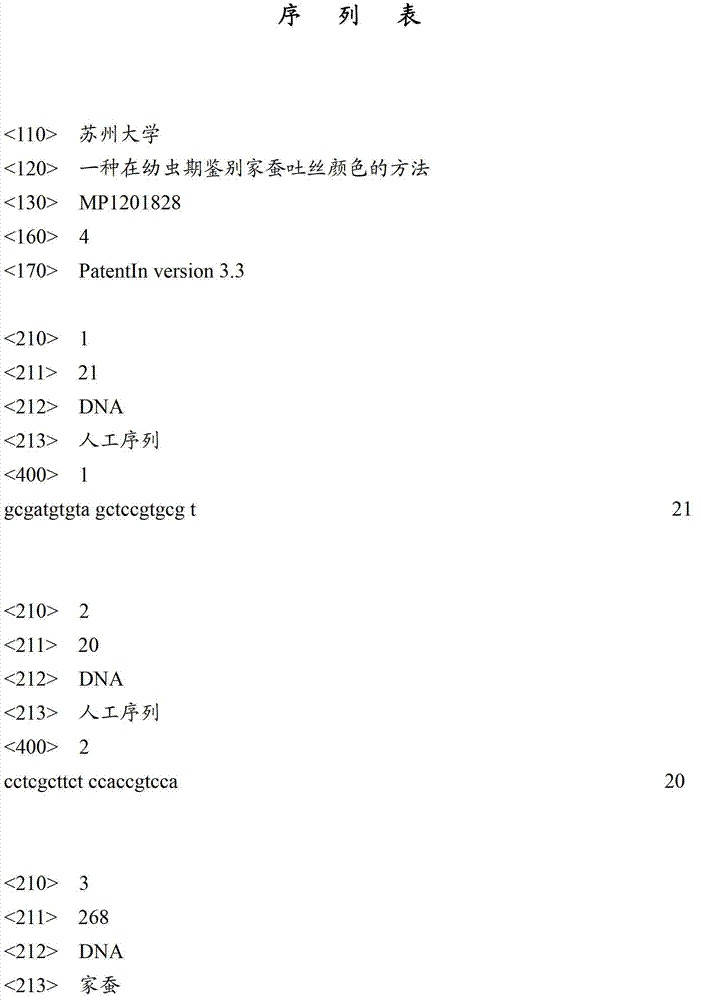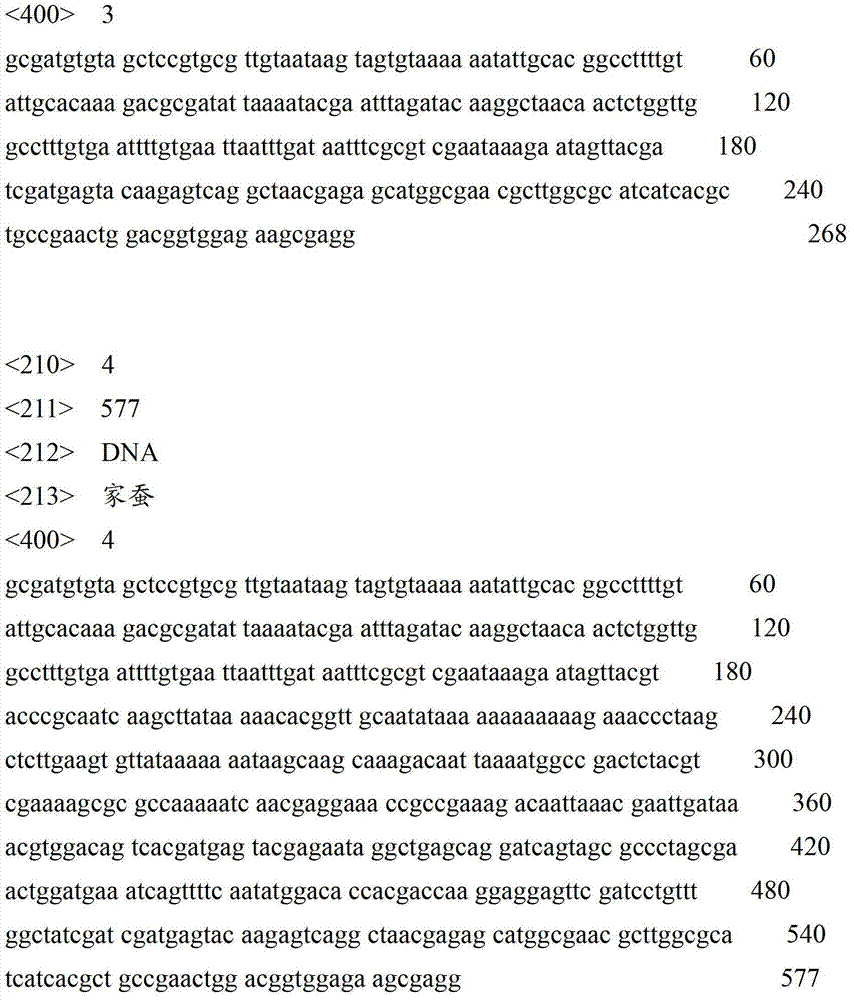Method for identifying silkworm silk color in larval stage
A technology for larval stage and silkworm, which is applied in the field of identifying silkworm spinning color in the larval stage, can solve the problems of unidentifiable, difficult to stabilize cocoon color of selected strains, and inability to simultaneously identify genotypes and preserve seeds.
- Summary
- Abstract
- Description
- Claims
- Application Information
AI Technical Summary
Problems solved by technology
Method used
Image
Examples
Embodiment 1
[0026] In order to identify the green cocoon Dazao variety with yellow-green cocoon color, the white cocoon variety C108 with pure white cocoon color, the yellow cocoon system Caicoon No. YO, this embodiment has carried out the following steps:
[0027] (1) The total RNA of the silk glands of the above four 5th instar larval samples was extracted with a commercial RNA extraction kit (Qiagen), and cDNA was synthesized by reverse transcription, and stored at -20°C to -40°C until use. For reverse transcription, use the reverse transcription kit from TaKaRa Company, reverse transcription reaction system (10 μL): 5×PrimeScript TM Buffer 2μL; PrimeScript TM EnzymeMixI 0.5μL; 50μmol / L Oligo dT Prime (50μmol / L) 0.5μL; Total RNA 1μL; add RNase FreeH 2 O to a total volume of 10 μL. The reverse transcription conditions were: 37°C for 15 minutes; 85°C for 5s.
[0028] (2) Using the four silkworm cDNAs obtained in step (1) as templates, using an upstream primer having a nucleotide se...
Embodiment 2
[0041] From the mixed populations with different cocoon layer colors and different chromaticity, the families with consistent cocoon color inside and outside and high color fastness were isolated.
[0042] (1) Raise in a single moth area, take a certain number of larval samples from each of the 100 moth areas at the 5th instar, and extract the total RNA from each larval silk gland according to the method described in Example 1, according to the embodiment cDNA was synthesized by the reverse transcription method described in 1, and stored at -20°C to -40°C for future use.
[0043] (2) Using the silk gland cDNA of Bombyx mori extracted in step (1) as a template, use the upstream primer with the nucleotide sequence shown in SEQ ID NO: 1 and the primer with the nucleotide sequence shown in SEQ ID NO: 2 For downstream primers, the Actin 3 gene was used as an internal reference gene, and RT-PCR was amplified according to the method described in Example 1.
[0044] (3) The RT-PCR am...
Embodiment 3
[0053] The homozygous yellow silk-spitting silkworm was selected from the mating of the homozygous yellow silk-spitting silkworm and the white cocoon excellent variety.
[0054] (1) The pure line Y12 of silkworm yellow cocoon was crossed with JS silkworm variety JS, which has a large amount of silk, high silk quality, and strong resistance. The blood of all larvae is all yellow 100 moth districts to get a certain number of larvae samples, and the total RNA extracted from each larvae silk gland according to the method described in Example 1 is reverse transcribed according to the method described in Example 1. Methods cDNA was synthesized and stored at -20°C to -40°C for future use.
[0055] (2) Using the silk gland cDNA of Bombyx mori extracted in step (1) as a template, use the upstream primer with the nucleotide sequence shown in SEQ ID NO: 1 and the primer with the nucleotide sequence shown in SEQ ID NO: 2 For downstream primers, the Actin 3 gene was used as an internal re...
PUM
 Login to View More
Login to View More Abstract
Description
Claims
Application Information
 Login to View More
Login to View More - R&D Engineer
- R&D Manager
- IP Professional
- Industry Leading Data Capabilities
- Powerful AI technology
- Patent DNA Extraction
Browse by: Latest US Patents, China's latest patents, Technical Efficacy Thesaurus, Application Domain, Technology Topic, Popular Technical Reports.
© 2024 PatSnap. All rights reserved.Legal|Privacy policy|Modern Slavery Act Transparency Statement|Sitemap|About US| Contact US: help@patsnap.com









